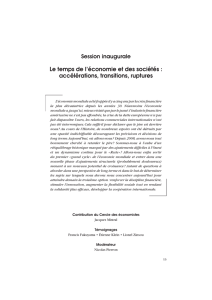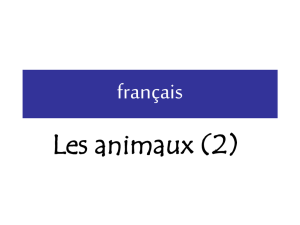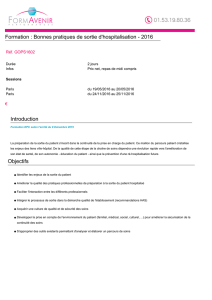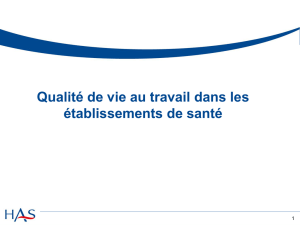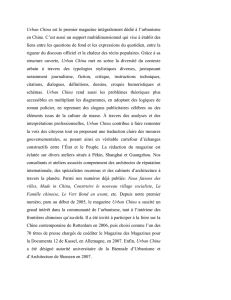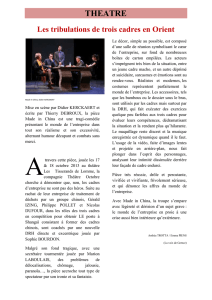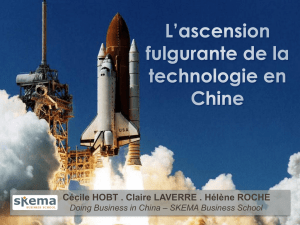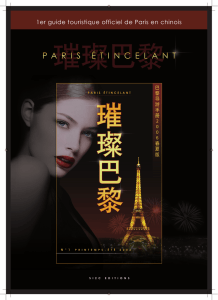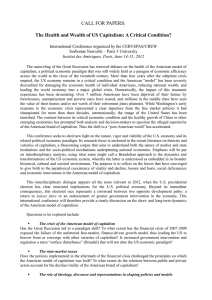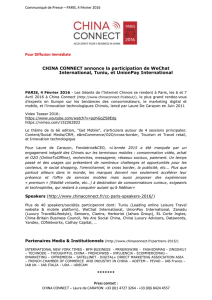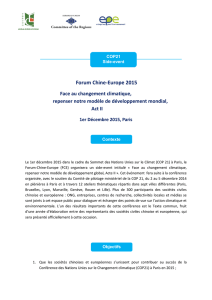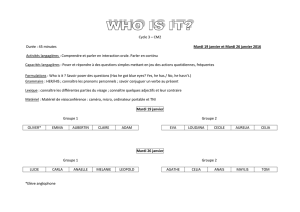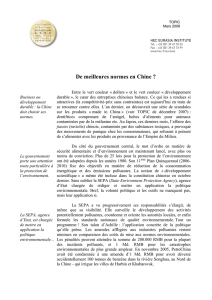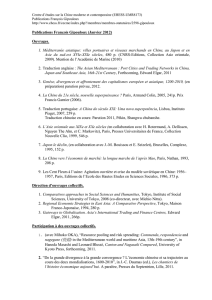Chapitre 6 - DCG
publicité
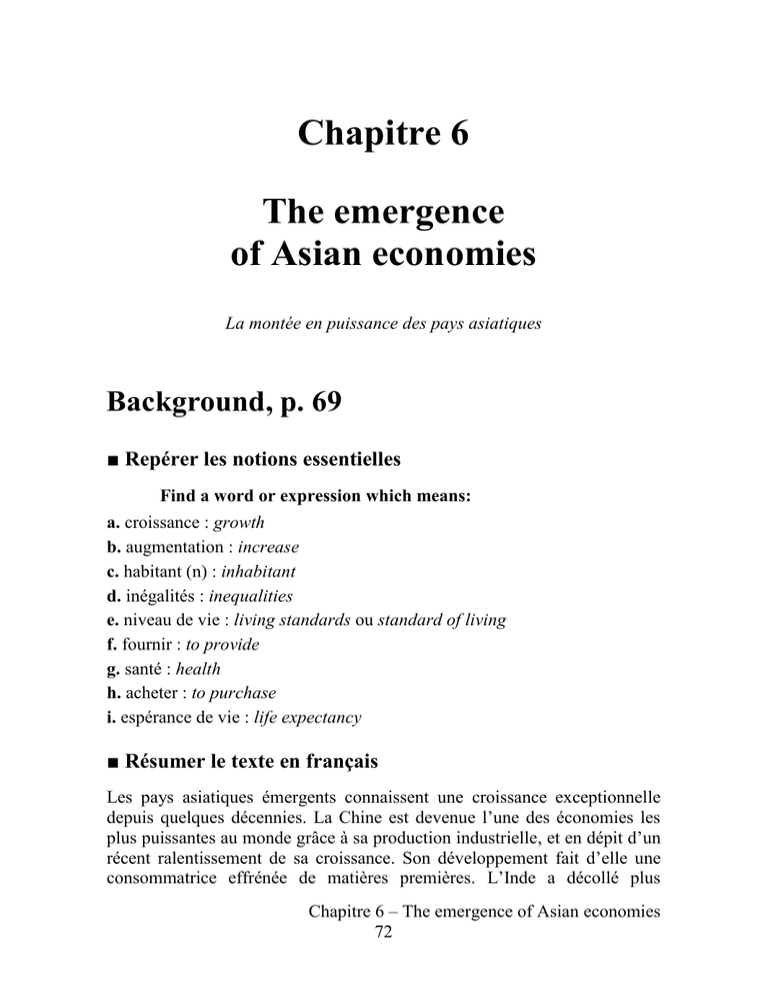
Chapitre 6 The emergence of Asian economies La montée en puissance des pays asiatiques Background, p. 69 ■ Repérer les notions essentielles Find a word or expression which means: a. croissance : growth b. augmentation : increase c. habitant (n) : inhabitant d. inégalités : inequalities e. niveau de vie : living standards ou standard of living f. fournir : to provide g. santé : health h. acheter : to purchase i. espérance de vie : life expectancy ■ Résumer le texte en français Les pays asiatiques émergents connaissent une croissance exceptionnelle depuis quelques décennies. La Chine est devenue l’une des économies les plus puissantes au monde grâce à sa production industrielle, et en dépit d’un récent ralentissement de sa croissance. Son développement fait d’elle une consommatrice effrénée de matières premières. L’Inde a décollé plus Chapitre 6 – The emergence of Asian economies 72 récemment grâce à son secteur de services où travaille une main-d’œuvre souvent anglophone bon marché. Ce pays souffre cependant de problèmes d’infrastructures et de logistique, et de fortes inégalités sociales qui ralentissent son développement. Parmi les places asiatiques qui connaissent depuis longtemps un développement remarquable, il y a Hong Kong et ses atouts en matière de finance ; la Corée du Sud, très à la pointe dans le secteur industriel ; Singapour et son positionnement géographique exceptionnel lui permettant d’être un acteur du commerce international, et enfin Taiwan et son maillage de petites sociétés. Plus récemment, le Vietnam, la Thaïlande, la Malaisie, l’Indonésie et les Philippines ont connu un essor grâce à leur main-d’œuvre bon marché. 168 mots ■ Approfondir Choose one Asian country and draw up a statistical fact sheet on its characteristics (capital, official language, head of state, population numbers, birth and death rates, surface area, GDP par capita, GDP growth, inflation rate, literacy rate, etc.). La réponse à cette question dépend des recherches personnelles. Lexical Work, p. 71 ■ Use the list Fill in the gaps with compound adjectives taken from the list. A definition of each adjective is given to help you. a. Taiwan has replaced its traditional labour-intensive industries such as toys and textiles by technology-intensive industries, moving them offshore to Malaysia or the Philippines. (which requires numerous workers / which uses or produces new technologies) b. Taiwan benefited from the arrival of many well-educated Chinese who fled communism. (who have a university diploma) c. South Korea has sustained a double-digit growth for decades. (said of a number of at least two figures) © Nathan 73 d. Seoul’s export-driven development strategy left the rural sector relatively underdeveloped despite efforts to improve rural living standards. (which is specialised in exports) e. For many years, Malaysia has been one of the world’s fast-growing emerging markets. (rising) f. Indian call centres rely on an English-speaking workforce. (who speaks English) g. China outsources its cheap labour industrial activities to Vietnam but its capital-intensive businesses remain in China as profit margins are higher. (using and producing a lot of capital) h. India is in dire need of groundbreaking reforms for entrepreneurs to overcome cumbersome bureaucratic hurdles. (using revolutionary methods) Grammar Work, p. 72 ■ Les différents emplois de as Analysez et traduisez les exemples suivants : 1. Countries such as Malaysia and the Philippines have developed recently. As est préposition. Such as : tels que. ➞Des pays tels que / comme la Malaisie et les Philippines se sont développés récemment. 2. Many countries think of China as a source of cheap products. As est préposition. As : comme. ➞De nombreux pays considèrent la Chine comme (étant une) source de produits bon marché. 3. As India lacks good roads, farmers find it difficult to sell their products. As est conjonction. As : puisque, étant donné que. ➞Comme / Étant donné que l’Inde manque / L’Inde manquant de bonnes routes, les agriculteurs ont du mal à vendre leurs produits. 4. As China becomes richer, so the gap between the poor and the rich is growing dramatically. As est conjonction. As : tandis que, alors que. ➞Tandis que / Comme la Chine s’enrichit, le fossé entre les pauvres et les riches se creuse de manière spectaculaire. Chapitre 6 – The emergence of Asian economies 74 1. Complétez les phrases suivantes avec la traduction anglaise de l’expression entre parenthèses. a. The advent of China as a global power is a challenge for all countries. b. As most cities are overcrowded, roads are congested all the time. c. A sea port such as Singapore can accommodate up to 40 cargo tankers whereas Mumbai has something like 9 berths to accommodate them. d. India’s young graduates may work as call centre employees as they speak English fluently. e. As Vietnam is developing at great speed, banks are lending more and more money to its entrepreneurs. ■ Since, for, ago, during, while Analysez les exemples suivants en observant particulièrement les temps utilisés, puis traduisez-les : 1. China has been the second most important economy in the world for a few years now. ➞ La Chine est la seconde plus grande économie au monde depuis quelques années. 2. Economic growth in Asia has averaged 5% since 2001. ➞ La croissance économique de l’Asie est d’environ 5 % depuis 2001. 3. A few months ago, China became the world’s leading emitter of CO2. ➞ Il y a quelques mois, la Chine est devenue le plus gros émetteur de CO2 au monde. 4. Vietnam’s economy suffered during the war against the USA. ➞ L’économie du Vietnam a souffert pendant / au cours de la guerre contre les États-Unis. 5. We visited a shipbuilding site while we were in South Korea. ➞Nous avons visité un chantier naval pendant que nous étions en Corée du Sud. 6. I stayed in Malaysia for three weeks. ➞J’ai séjourné en Malaisie pendant trois semaines. / J’ai passé trois semaines en Malaisie. ■ For se traduit par « depuis » quand le verbe est au present perfect et par « pendant / au cours de » quand le verbe est au prétérit. © Nathan 75 2. Complétez les phrases suivantes avec la traduction en anglais des expressions entre parenthèses. a. Fifty years ago, China was one of the world’s poorest countries. (Il y a 50 ans) b. Korea’s shipbuilding firms will enjoy a boom for many years still. (pendant de nombreuses années) c. Since the 1997 crisis, corporate restructuring has improved the financial health of Korean companies. (Depuis la crise de 1997) d. During the next 20 years the population in India will keep rising. (Pendant les 20 prochaines années) e. While China was preparing the Olympic games in 2008, there was an earthquake in Sichuan, killing 90,000 people. (Pendant / Alors que la Chine préparait) f. In 2008, during the toxic baby milk scandal in China, at least 300,000 infants were taken ill. (au cours du) 3. Complétez les phrases suivantes en utilisant for, since ou ago, combiné avec le repère proposé entre parenthèses. Puis, posez une question sur la phrase commençant par How long ou How long ago, et traduisez le tout. a. China has produced inexpensive goods for years and years now. How long has China been producing inexpensive goods? La Chine produit des marchandises bon marché depuis des années et des années. Depuis combien de temps la Chine produit-elle des marchandises bon marché ? b. Tata Motors has been selling its Nano car since 2008. How long has Tata Motors been selling its Nano car? La société Tata Motors vend sa voiture, la Nano, depuis 2008. Depuis combien de temps Tata Motors vend-il sa voiture, la Nano ? Chapitre 6 – The emergence of Asian economies 76 c. China started reforming its economy more than three decades ago. How long ago did China start reforming its economy? La Chine a commencé à réformer son économie il y a plus de trois décennies. Cela fait combien de temps que la Chine a commencé à réformer son économie ? d. Taiwan’s economy has been based on a strong spirit of entrepreneurship for a long time. How long has Taiwan’s economy been based on a strong spirit of entrepreneurship? L’économie de Taïwan est fondée sur un sens aigu de l’entrepreneuriat depuis longtemps. Depuis combien de temps l’économie de Taiwan est-elle fondée sur un sens aigu de l’entrepreneuriat ? e. The Philippines has lagged behind since the financial crisis. How long have the Philippines lagged behind? Les Philippines sont à la traîne depuis la crise financière. Depuis combien de temps les Philippines sont-elles à la traîne ? f. For a long time, all these Asian countries were colonies. How long were all these Asian countries colonies? Tous ces pays asiatiques ont été des colonies pendant longtemps. Combien de temps tous ces pays asiatiques ont-ils été des colonies ? g. Our Asian supplier has been making these toys for six months. How long has our Asian supplier been making these toys? Notre fournisseur asiatique fabrique ces jouets depuis six mois. Depuis combien de temps notre fournisseur asiatique fabrique-t-il ces jouets ? © Nathan 77 4. Traduisez en anglais les phrases suivantes. a. Leur PIB a augmenté de 6 % au cours des trois dernières décennies. Their GDP has increased by 6% during the last three decades (over the past three decades). b. Depuis combien de temps Hong Kong est-il chinois ? – Depuis plusieurs années. How long has Hong Kong been Chinese ? – For several years. c. Depuis la fin des années 1990, des pays comme le Vietnam connaissent un essor important. Since the end of the 1990s, countries like Vietnam have expanded / developed / grown rapidly. d. Il n’y a pas très longtemps, comme tous ces pays étaient très pauvres, les enfants mouraient de faim. Not very long ago, as all these countries were very poor, children died of starvation / hunger. e. Pendant dix ans, notre fournisseur nous a vendu ce riz comme étant le meilleur. For ten years, our supplier sold us this rice as being the best. f. Cela fait combien de temps que Hong Kong est revenu à la Chine ? How long ago did Hong Kong come back under Chinese rule? Chapitre 6 – The emergence of Asian economies 78 Exam Work, p. 74 1. COMPRÉHENSION. D’après l’auteur, quels facteurs entravent l’économie chinoise aujourd’hui ? (120 mots environ.) L’économie chinoise fait face à divers obstacles externes et internes qu’il va lui falloir surmonter. L’essoufflement des échanges commerciaux au niveau mondial retentit sur ses exportations, de moindre volume désormais. Conséquemment, les investissements industriels sont moins profitables que par le passé. La Chine parvient à maintenir un taux de croissance honorable en alimentant son secteur secondaire par le crédit, ce qui entraîne des phénomènes de surcapacité de production, en particulier dans le secteur de l’acier. Il s’agit pour la Chine d’opérer une transition vers une économie de services, ce qui est malaisé car le secteur des services est surprotégé par une réglementation anti-concurrence contraignante qui en freine le développement. De plus, certaines rigidités administratives ralentissent les flux de main d’oeuvre qui pourraient contribuer à dynamiser l’économie. 126 mots 2. EXPRESSION. Rédigez le courrier suivant. (150 mots environ.) France Bétons (address of company) 12 March 20.. Managing Director (name of Chinese company) (address of company) Dear Sir / Madam Our firm specializes in the production of concrete parts for construction. We have produced tiles for twenty years now and recently developed a unique © Nathan 79 technology to produce tiles in greater quantities at a lower price. You will find enclosed a brochure with the complete description of our products and the revolutionary technique we are using. As you are already well-established in the construction market of your area, we propose a joint venture in order to produce concrete tiles thanks to our unique technology, as such tiles are more resistant than the traditional clay ones. If you are interested in taking this further, we could set up a meeting when our Managing Director, Mr Chevalier, is in China next month. Such a meeting would enable you to discuss arrangements and other legal matters. Yours faithfully Jacques DUPUIS Assistant to the Director of International Relations Enc : 1 3. COMPREHENSION. Why is consumer spending slowing down in Southeast Asia? (About 120 words) With its huge emerging middle class, Southeast Asia was expected to become a region filled with die-hard consumers, but the prospect of such an economic miracle has turned sour. This is due to both global and local factors. The global economic slowdown after the financial crisis, combined with China’s weakening clout, is hindering household consumption. Households are often in debt and do not see their wages rise as much as they might wish. Though consumption levels rose sharply after the crisis, this was short-lived. Rampant indebtedness has definitely stalled consumption. Another factor is political instability, which discourages investments. Eventually, the drop in the price of raw materials such as cotton or rubber leads to less wealth and compounds the debts of South East Asians. 125 words 4. COMPREHENSION. What is the source of India’s economic dynamism? (About 150 words.) Contrary to the other BRIC nations (Brazil, Russia and China), India is increasingly buoyant, economically-speaking. Chapitre 6 – The emergence of Asian economies 80 Its dynamism is essentially industrial, more particularly in the textile and garment sector. This has sparked optimism on the part of investors. The main reason for this renewed vigour is the relative slowdown of the profitability of Chinese production, which has made India much more attractive for investments. China’s rising wages in the industrial sector, along with its military conflicts with other countries, have actually benefited India, which is now considered to be a safer and more profitable place to do business. The second reason is that India, which needs to import energy, has taken advantage of the recent drop in oil prices. This has led to lower transport costs and even reduced inflation and government debt, since state subsidies to support production have declined. Conversely, Russia and Brazil, which depend on the export of raw materials, have had a harder time competing on a global scale. 162 words 5. COMPREHENSION. What are the problems Asian countries need to solve in order to make the 21st century the Asia century? (About 110 words.) In order to become the leading continent in the 21st century, Asia has economic, demographic and governmental challenges to overcome. Asian countries need to address extreme poverty and social inequality, but also stagnating wages within their emerging middle classes. Moreover, they cannot rely on a young population forever and will eventually have to adapt to an ageing population. Today, Asia's future success depends on implementing the right economic and social policies and properly developing the financial sector, while mitigating social ailments. The challenges to achieve a successful transition to a post-industrial age are numerous and intertwined. 96 words 6. EXPRESSION. Describe the cartoon and explain what it is about. Why is the Chinese dream compared to the Titanic? (About 150 words.) The cartoon depicts a huge cargo ship crossing the ocean, blithely unaware of potentially dangerous icebergs floating around. The captain seems to be optimistic about his ability to navigate through the dangers. Instead of being filled with containers, the ship is topped by an enormous factory with three © Nathan 81 smoke stacks. One of the icebergs lying ahead of the ship is called “economy”. All of this is a metaphor for China’s giant economy facing new, unforeseen challenges which could hinder its success, if not sink it altogether. Just as the Titanic was thought to be unsinkable because of its size and power, China is sometimes believed to be eternally buoyant, but this may not be the case after all. China's economy, which is essentially based on industrial output, now faces unprecedented challenges because industrial production no longer boosts growth as much as it did in the past. 146 words 7. COMPRÉHENSION. Vous rédigerez une note de synthèse en français, expliquant quels sont les défis et les opportunités des économies asiatiques dont il est question dans les documents 1 à 5. (Environ 200 mots.) L’ensemble des documents indique que les pays asiatiques connaissent des problèmes de croissance dus à des crises ou à des mutations économiques, mais qu’ils sont néanmoins bien placés pour dominer l’économie mondiale. Pour autant, rien n’est garanti car les défis sont nombreux et complexes (document 4). Le document 2 évoque la crise économique qui a ralenti les échanges commerciaux mondiaux, empêchant certains partenaires de maintenir leur taux de croissance. Localement, l’essoufflement de la Chine affecte ses partenaires commerciaux, sauf l’Inde avec son secteur industriel développé et qui profite de la chute des cours pétroliers (document 3). Tous ces pays doivent affronter à plus ou moins long terme des mutations profondes, en particulier le passage à une économie de services, comme la Chine, qui peine à évoluer pour des raisons de gouvernance mal adaptée (documents 1 et 4). D’autres pays asiatiques, comme la Thaïlande, l'Indonésie ou la Malaisie (document 2), ont également du mal à sortir du piège des revenus intermédiaires stagnants : ils sont ralentis par une conjoncture défavorable et la chute du cours de nombreuses matières premières dont ils dépendent pour doper leur taux de croissance. Pour dominer le XXIe siècle, ces pays doivent passer à un modèle économique post-industriel tout en corrigeant les inégalités sociales et en anticipant sur le vieillissement de la population, comme l’indique le document 4. 221 mots Chapitre 6 – The emergence of Asian economies 82 8. EXPRESSION. Rédigez un courrier. Royal Asian Palm Wisma View 50450 Kuala Lumpur MALAYSIA 25 April 20.. Managing Director (address of British company) Dear Sir / Madam Our company is specialised in exporting organic Malaysian palm oil to Asian and European markets. We buy our oil from producers who do not use chemicals to extract oil but use traditional methods instead, in order to respect the environment. That is why our oil is particularly recommended for the production of organic margarine and frying oil. Moreover, the palm producers with whom we work are committed to sustainable development and follow a strict policy of integrated agriculture in order to respect local ecosystems. We are looking for an importer in Great Britain. Your company was recommended to us as being committed to sustainable development. That is why we think you might be interested in our offer. We can send samples on request so that you can test the oil. We grant rebates on large orders and a percentage, to be discussed, of our export revenues. We look forward to hearing from you. Yours faithfully Simon ADAMS Export Manager © Nathan 83

